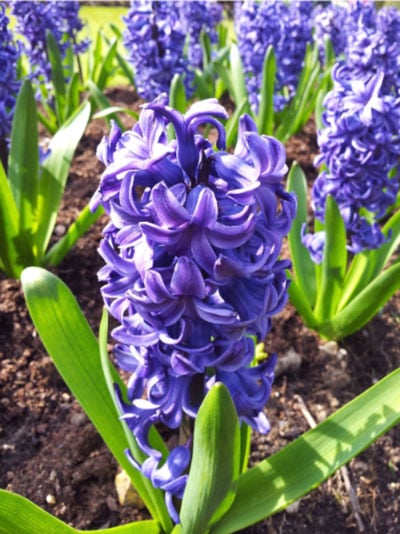Teach This Poem, though developed with a classroom in mind, can be easily adapted for remote-learning, hybrid-learning models, or in-person classes. Please see our suggestions for how to adapt this lesson for remote or blended learning. We have also noted suggestions when applicable and will continue to add to these suggestions online.

Look closely at the image of the hyacinth flower.
The following activities and questions are designed to help your students use their noticing skills to move through the poem and develop their thinking about its meaning with confidence, using what they’ve noticed as evidence for their interpretations. Read more about the framework upon which these activities are based.
- Warm-up: Look closely at the image of the hyacinth flower. What stands out to you about this flower? Why?
- Before Reading the Poem: Look closely at the image of Sappho’s fragments. What do you notice in the fragments? Look again. What else stands out to you?
- Reading the Poem: Silently read the poem “One Girl” by Sappho. What do you notice about the poem? Note any words or phrases that stand out to you or any questions you might have.
- Listening to the Poem (enlist two volunteers to read the poem aloud): Listen as the poem is read aloud twice, and write down any additional words and phrases that stand out to you.
- Small-group Discussion: Share what you noticed about the poem with a small group of students. Based on the details you just shared with your small group and the images from the beginning of class, how are the two resources connected to the poem? Much of Sappho’s work remains in fragments. How might this inform your reading of the poem?
- Whole-class Discussion: What might the significance of the title “One Girl” be? How are the two sections in the poem similar and/or different? How might the poem be different with just section one or just section two? (Teachers, your students might enjoy looking at another translation of the poem/fragment. You will need to scroll down to stanzas 23 and 24.)
- Extension for Grades 7-8: In honor of National Translation Month, read two to three poems in translation. (Teachers, you may want to preselect poems that suit your students’ comprehension level.) With your classmates, create small groups to discuss your poems and your thoughts on reading poetry in translation. Why might it be important to read poetry in translation? Can you think of any other authors in translation?
- Extension for Grades 9-12: In honor of National Translation Month, join with a classmate and try translating a poem. (Teachers, we suggest that you preselect poems from this list of poems in translation and offer students just the poem in the original language. If your school offers language courses, you might want to partner with a language teacher. Your students might enjoy working in small groups to translate the same poem, which would allow them to compare translations later.) Share your poem in translation and your experience with your classmates.
“Sappho is not only one of the few women poets we know of from antiquity, but also is one of the greatest lyric poets from any age. Most of her poems were meant to be sung by one person to the accompaniment of the lyre (hence the name, “lyric” poetry). Rather than addressing the gods or recounting epic narratives, such as those of Homer, Sappho’s verses speak from one individual to another. They speak simply and directly to the “bittersweet” difficulties of love. Many critics and readers alike have responded to the personal tone and urgency of her verses, and an abundance of translations of her fragments are available today.” Read more about Sappho.
